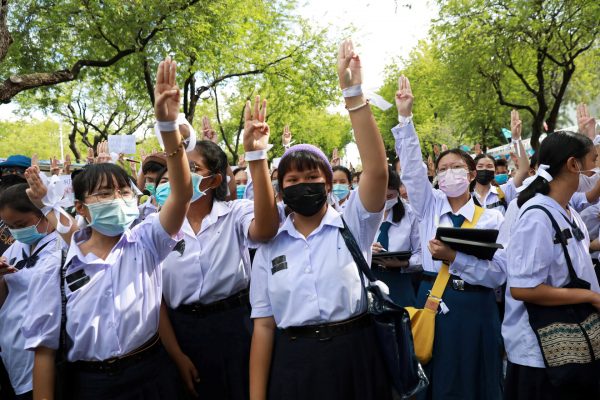Future Forward did much to mobilise young and progressive voters in the March 2019 election and established itself as a major opposition party to the coalition government led by Prime Minister Prayut Chan-o-cha. After the party’s dissolution in February 2020, the Student Union of Thailand and its allies successfully organised anti-government flash mobs across university campuses until the country went into lockdown in response to the COVID-19 pandemic at the end of March. As restrictions eased in June, the alleged forced disappearance of a Thai human rights activist, Wanchalearm Satsaksit, triggered a new round of protests as #savewanchalearm became the biggest-trending hashtag on Thai Twitter.
The current round of anti-government protests displays similarities and differences to protest movements Thailand has seen over the past two decades. Demands made by the protesters are similar to those of previous generations of pro-democracy movements: they want a legitimately elected government, greater protection of civil liberties and a new, more democratic and inclusive constitution.
Such discontent reflects deeper underlying grievances related to unchecked elite power, wealth concentration and resource encroachment by cronies, irresponsive governance, blatant corruption and a deepening authoritarian culture. The re-adoption of old insults for conservatives and the Twitter-led campaign to ban the conservative Nation media group’s publications demonstrate the continued saliency of the red–yellow divide in Thai politics.
Yet the current protest movement is venturing into new territory as well. The 10-point list of demands released by the United Front of Thammasat and Demonstration, a high-profile student organisation, is unprecedented: it demanded major reforms of the monarchy, which include a demand for reductions in the king’s budget, no royal interference in politics and the abolishment of lese majeste.
The mobilisation of high school students in the Free Youth movement, both as active participants and leaders, is another novelty. Leaders of some high school protest groups credited the university student-led protests as an inspiration for them to defy a rigidly hierarchical system that disempowers the young, a highly unequal education system that favours the rich and a repressive culture that rewards conformity and punishes individuality.
A Twitter campaign based around the hashtag #AfterSchoolLetsGoToTheMinistry and led by high school protest groups shows that youngsters feel that adults in their lives are dismissive of their aspirations, and that the ruling elites treat them as immature naive subjects that cannot think for themselves. They seek a more progressive notion of Thainess that can accommodate diversity, democracy and equality. The growing participation of young Thais, who grew up under Prayut’s rule, reflects the Prime Minister’s failure to effectively communicate with the younger generation, to inspire hope and progress for the future.
One defining feature of the Free Youth movement is its organisational structure and the pivotal role being played by Twitter. Organisationally, the youth protests are less structured, more decentralised and less connected to political parties compared to their predecessors. Networked primarily on social media, protesters are recruited and mobilised first online, often through hashtag discoveries, which then spawn subsequent offline interactions.
Our network analysis of posts made under the hashtag #FreeYouth, one of the most popular in recent weeks, shows that the key influencers of this viral hashtag are ordinary people — not famous politicians, journalists or celebrities. That the grassroots are driving the online protest discourses is a good indicator that the movement remains largely horizontally networked and not driven by influential figures.
The rise of Twitter as a main protest mobilisation platform was driven by a significant uptake of the social media platform by Thais between the ages of 18 to 24 in the past few years. Organisers of recent high school protest activities saw Twitter as playing a critical role in expanding their knowledge in politics and allowing them to step out of the shadows of their conservative ‘yellow shirt’ parents.
The main challenge going forward for the Free Youth movement is to expand its narrow base. Currently, the movement is confined to largely youth groups, mostly drawn from the urban middle class. There has been some positive sign that the movement is evolving to include non-youth pro-democracy groups like the Free People group, led by former red shirt activists.
The government has sought to put pressure on the senior management of schools and universities to come down on student activism and to delegitimise the students’ demands by asserting that the students ‘don’t know their place’. Such comments from Thailand’s leaders are unhelpful, and are likely to fuel continued protests from both students and beyond.
Aim Sinpeng is a lecturer in the Department of Government and International Relations at the University of Sydney.
Janjira Sombatpoonsiri is a researcher at Chulalongkorn University and an associate fellow at the German Institute for Global Studies.

